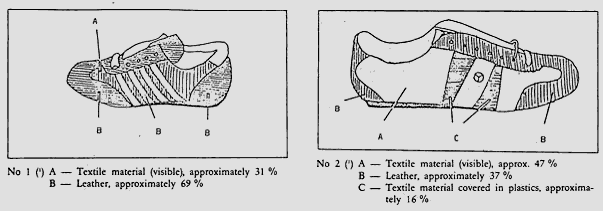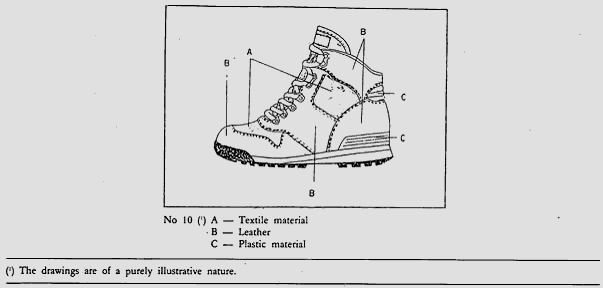
COMMISSION REGULATION (EEC) No 3801/92of 23 December 1992 concerning the classification of certain goods in the Combined Nomenclature - "Official Journal of the European Communities", No L 117/31 of 13.5.1993 - |
THE COMMISSION OF THE EUROPEAN COMMUNITIES,
Having regard to the Treaty establishing the European Economic Community,
Having regard to Council Regulation (EEC) No 2658/87 of 23 July 1987 on the tariff and statistical nomenclature and on the Common Customs Tariff(1), as last amended by Commission Regulation (EEC) No 3800/92(2), and in particular Article 9 thereof,
_____________
(1) OJ No L 256, 7. 9. 1987, p. 1.
(2) See page 8 of this Official Journal.
Whereas in order to ensure uniform application of the combined nomenclature annexed to the said Regulation, it is necessary to adopt measures concerning the classification of the goods referred to in the Annex to this Regulation;
Whereas Regulation (EEC) No 2658/87 has set down the general rules for the interpretation of the combined nomenclature and these rules also apply to any other nomenclature which is wholly or partly based on it or which adds any additional subdivisions to it and which is established by specific Community provisions, with a view to the application of tariff or other measures relating to trade in goods;
Whereas, pursuant to the said general rules, the goods described in column 1 of the table annexed to the present Regulation must be classified under the appropriate CN codes indicated in column 2, by virtue of the reasons set out in column 3;
Whereas it is appropriate that binding tariff information issued by the customs authorities of Member States in respect of the classification of goods in the combined nomenclature and which do not conform to the rights established by this Regulation, can continue to the invoked under the provisions in Article 65 of Commission Regulation (EEC) No 3796/90(3), for a period of three months by the holder if a binding contract has been concluded such as is envisaged in Article 14 (3) (a) or (b) of Commission Regulation (EEC) No 1715/90(4);
Whereas this Regulation concerns also the products referred to in Commission Regulation (EEC) No 1074/80(5); whereas, therefore, the latter should be repealed;
______________
(3) OJ No L 365, 28. 12. 1990, p. 17.
(4) O OJ No L 160, 26. 6. 1990, p. 1.
(5) OJ No L 113, 1. 5. 1980, p. 54.
Whereas the measures provided for in this Regulation are in accordance with the opinion of the Nomenclature Committee,
HAS ADOPTED THIS REGULATION:
Article 1
The goods described in column 1 of the annexed table are now classified within the combined nomenclature under the appropriate CN codes indicated in column 2 of the said table.
Article 2
Binding tariff information issued by the customs authorities of Member States which do not conform to the rights established by this Regulation can continue to be invoked pursuant to the provisions of Article 6 of Regulation (EEC) No 3796/90 for a period of three months by the holder if a binding contract has been concluded as envisaged in Article 14 (3) (a) or (b) of Regulation (EEC) No 1715/90.
Article 3
Regulation (EEC) No 1074 is hereby repealed.
Article 4
This Regulation shall enter into force on the 21st day following its publication in the Official Journal of the European Communities.
This Regulation shall be binding in its entirety and directly applicable in all Member States.
Done at Brussels, 23 December 1992.
For the Commission
Christiane SCRIVENER
Member of the Commission
ANNEX
Description |
CN |
|
(1) |
(2) |
(3) |
1. Training shoes with outer soles of coarsely patterned rubber or plastics and uppers of textile material on which strips of leather and/or plastics-coated textile material are sewn externally in various combinations, covering the surface up to approximately 70 %. (See sketch Nos. 1 to 6) |
6404 11 00 |
Classification is determined by general rules 1 and 6 for the interpretation of the combined nomenclature by notes 3 and 4 (a) and the additional note 1 to Chapter 64 and by the wording of CN codes 6404 and 6404 11 00. |
2. Training shoes with a rubber outer sole, a 27-cm long in-sole and a plastics upper on the outside of which are sewn leather strips or pieces covering about 40 % of the surface. |
6402 99 93 |
Classification is determined by general rules 1 and 6 for the interpretation of the combined nomenclature by note 4 (a) and the additional note 1 to Chapter 64 and by the wording of CN codes 6402, 6402 99 and 6402 99 93. |
3. Training shoes with outer soles of plastics and textile uppers on which are sewn at various points pieces of leather (65 %) and plastics (18 %). (See sketch No 7) |
6404 11 00 |
Classification is determined by general rules 1 and 6 for the interpretation of the combined nomenclature, by notes 3 and 4 (a) and the additional note 1 to Chapter 64 and by the wording of CN codes 6404 and 6404 11 00. |
4. Training shoes which cover the ankle, with outer soles of coarsely patterned rubber and uppers of plastics (79 %) and leather (21 %) completely covering the textile internal shell, which serves as a lining on to which the leather and plastics are sewn. (See sketch No 8) |
6402 91 90 |
Classification is determined by general rules 1 and 6 for the interpretation of the combined nomenclature, by note 4 (a) and the additional note 1 to Chapter 64 and by the wording of CN codes 642, 6402 91 and 6402 91 90 |
5. Training shoes which cover the ankle with in-soles of not less than 24 cm, outer soles of coarsely patterned rubber and uppers of leather (84 % and plastics (16 %) completely covering an inner shell of textile material which could not itself serve as the outer part of the upper. The leather and plastics are sewn onto the shell. (See sketch No 9) |
6403 91 13 |
Classification is determined by general rules 1 and 6 for the interpretation of the combined nomenclature, by notes 3 and 4 (a) and the additional note 1 to Chapter 64 and by the wording of CN codes 6403, 6403 91 and 6403 9113 |
6. Hiking/trekking boots which cover the ankle, with outer soles of coarsely patterned rubber and uppers comprising a textile bootee, on to which are sewn pieces of leather covering about 80 % of the external surface excluding the area of the integral tongue. (See sketch No 10) |
6406 19 90 |
Classification is determined by general rules 1 and 6 for the interpretation of the combined nomenclature, by note 4 (a) and the additional note 1 to Chapter 64 and by the wording of CN codes 6404, 6404 19 and 6404 19 90. |



CORRIGENDA
Corrigendum to Commission Regulation (EEC) No 3800/92 of 23 December 1992 amending Council Regulation (EEC) No 2658/87 on the tariff and statistical nomenclature and on the Common Customs Tariff
(Official Journal of the European Communities No L 384 of 30 December 1992)
On page 8 in Article 1, Additional note, in the first paragraph, third line:
for: "which covers",
read: "attached to";
in the second paragraph, second line:
for: "and/or",
read: "or".
Corrigendum to Commission Regulation (EEC) No 3801/92
of 23 December 1992 concerning the classification of certain goods in the combined nomenclature
(Official Journal of the European Communities No L 384 of 30 December 1992)
On page 9, in the fourth recital, sixth line:
for: "Article 65",
read: "Article 6";
in Article 3:
for: "Regulation No 1074",
read: "Regulation No 1074/80";
on page 10, in the Annex, in the "Description" column:
item 2, shall read as follows:
"2. Training shoes with rubber outer soles, 27-cm long in-soles and plastic uppers on which are sewn leather strips or pieces covering about 40 % of the surface.";
item 5 shall read as follows:
"5. Training shoes which cover the ankle, with outer soles of coarsely patterned rubber, in-soles of not less than 24 cm and uppers of leather (84 %), and in plastics (16 %), completely covering an inner sfyell of textile material which could not itself serve as the outer part of the upper. The leather and plastics are sewn onto the shell. (See sketch No 9)";
Item 6 shall read as follows:
"6. Hiking/trekking boots (footwear which cover the ankle), with outer soles of coarsely patterned rubber and uppers of textile material, on which are sewn pieces of leather covering about 80 % of the surface (See sketch No 10)".
in the "CN classification" column against item 6:
for: "6406 19 90",
read: "6404 19 90";
in the third column:
in the heading insert:
"Reasons";
in item 4, column 3, fourth line:
for: "... codes 642...",
read: "... codes 6402...";
on pages 11 and 12 in the text immediately beneath drawings Nos 7, 8, 9 and 10, B:
for: "Plastic material",
read: "plastics material"